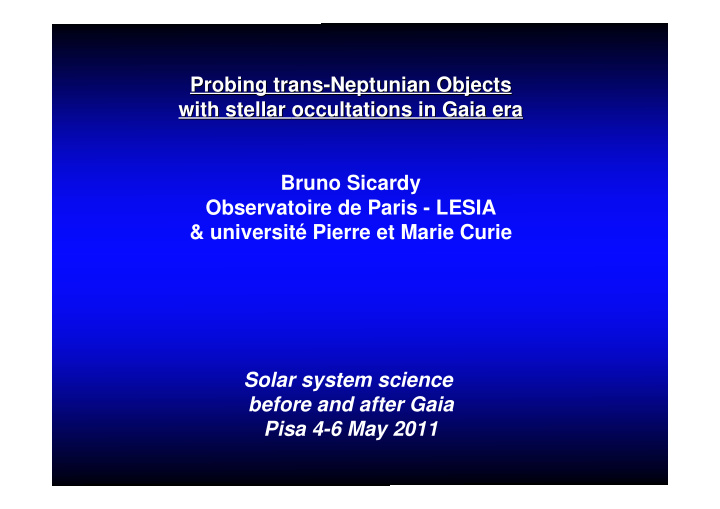



Probing trans-Neptunian Objects Probing trans-Neptunian Objects with stellar occultations in Gaia occultations in Gaia era era with stellar Bruno Sicardy Observatoire de Paris - LESIA & université Pierre et Marie Curie Solar system science before and after Gaia Pisa 4-6 May 2011
Doressoundiram & Lellouch, "Aux confins du système solaire"
airless Trans-Neptunian Objects (TNO's) radius, shape & limb features at kilometric accuracy density, if mass known from satellite motion ---> internal structure albedo ---> composition, state of surface if double occultation primary/secondary: accuracy ~ 10 km, e.g. Pluton/Charon ---> better orbital elements
TNO's with atmosphere density & temperature profiles down to nbar levels variations with time detection of activity ( e.g. gravity waves) zonal winds measurements through central flash haze properties through chromatic dependence
strength: can achieve what nobody else can do weakness: difficult to predict, and thus to plan, especially on large telescopes ⇒ depending on body and background stellar field: one occultation of interest every month, year, decade
New York Times 11 January 2011: "The War of the Worlds, Round 2"
Haumea Makemake
Haumea Makemake
~ 3x3 arcmin fields of view Pluton ~ 240 candidates Eris ~ 1 candidate 06 Nov. 2010 in 2011 next: 29 August 2013
thousands of stars measured against UCAC2 stars positions → r.m.s. deviations ~ 50 mas THEN updates 1-3 weeks before → accuracy 20-30 mas M. Assafin et al. (ON, Rio de Janeiro) R. Behrend (Geneva Obs) J.L. Ortiz et al. (IAA Granada)
www.lesia.obspm.fr/perso/bruno-sicardy/
rms 20 mas rms 40 mas
Titan quaoar 0.033 arsec stamp at (33 mas) 140 km Eris Pluton Makemake Charon
2003 AZ 84
0.89" 2UCAC 26257135 (D. Herald, Aug. 2004)
Charon
R= 603.6 ± 1.4 km Sicardy et al., Nature 439 , 52, 2006 « Charon ʼ s size and an upper limit on its atmosphere from a stellar occultation »
Varuna predicted Rio de Janeiro group & Raoul Behrend (Geneva) São Luis observed 45 mas Quixadá ( ∆ t= 36 sec) distance: 42.75 UA
São Luis, Maranhão, Brazil,February 2010, F. Colas
São Luis, Brazil telescope 12.5 cm, alt.: 2 m F. Colas Mangrove, São Luis, from http://www.blogg.org/blog-16247-offset-415.html
something expected at Quixadá around here Quixadá F. Braga Ribas F. Vachier 1 clouds… flux ratio 1 São Luis F. Colas 52.5 sec 0 0 UT (sec)
dark (p v =0.04) dark (p v =0.04) most elongated least elongated probability ~ 0.3 probability ~ 0 860x375 km 610x525 km São Luis brightest possible (p v =0.12) probability ~ 0 Quixadá 502x218 km most probable in this corner
Eris 6 novembre 2010, Sicardy et al. Nature 2011, to be submitted
Emmanuel Jehin, 60 cm Alain Maury, 50 cm La Silla Sand Pedro de Atacama
most remote object observed in solar system (97 UA, 15 billions km) p V close to one → one of brightest objects of solar system atmospheric limit of N 2 ~ 1 nanobar (10 -4 × Pluton atmosphere) Pluto min. radius
2006 Eris no! 2010
Mike W… 4 decembre 2010, 14:03 Dear Mr. Sikardy,[…] I am an artist/writer/attorney and have loved Pluto since I first learned about as a little boy. I asked President George W. Bush in July 2002 when I met him in Portland, Oregon […] Anyway, I am very glad that Eris will lose more diameter based on the final calculations of the stellar occultation. Given the bad behavior of Mike "Pluto-Killer" Brown, it would make it even more joyous, I must admit, if Eris were to lose enough diameter to make it virtually certain that Pluto is larger. Alan Stern told me that New Horizons, baring a mishap, will measure Pluto's diameter, too.
2003 AZ84
2003 AZ84 ~60 mas
Makemake
Makemake ~60 mas
VLT NTT
Quaoar
Quaoar ~30 mas
Quaoar, San Pedro de Atacama 50-cm, 4 May 2011
UCAC2 catalog + update + Pluto ephemeris correction UCAC2 catalog + update + Pluto ephemeris correction ABOUT 1400 EVENTS posted on B. Sicardy's home page
www.lesia.obspm.fr/perso/bruno-sicardy/
Conclusions Conclusions TNOs occultations in Gaia's occultations in Gaia's era era TNOs at < 1 mas accuracy: huge relieve in occultation planning (now 99% time spent in astrometric predictions & updates) chose TNO, chose telescope, get many chords on body (size, shape & limb features at km-accuracy) TNOs with atmosphere (Pluto,…): central flash → zonal winds, haze properties get satellites: shape & orbital elements photo Alain Maury
Recommend
More recommend